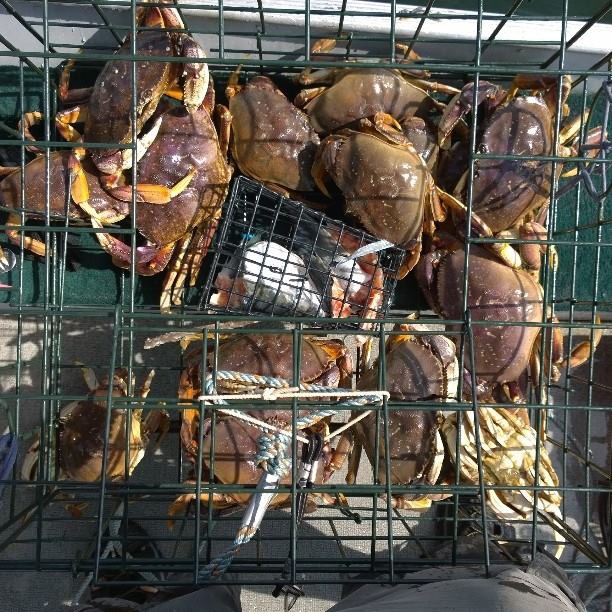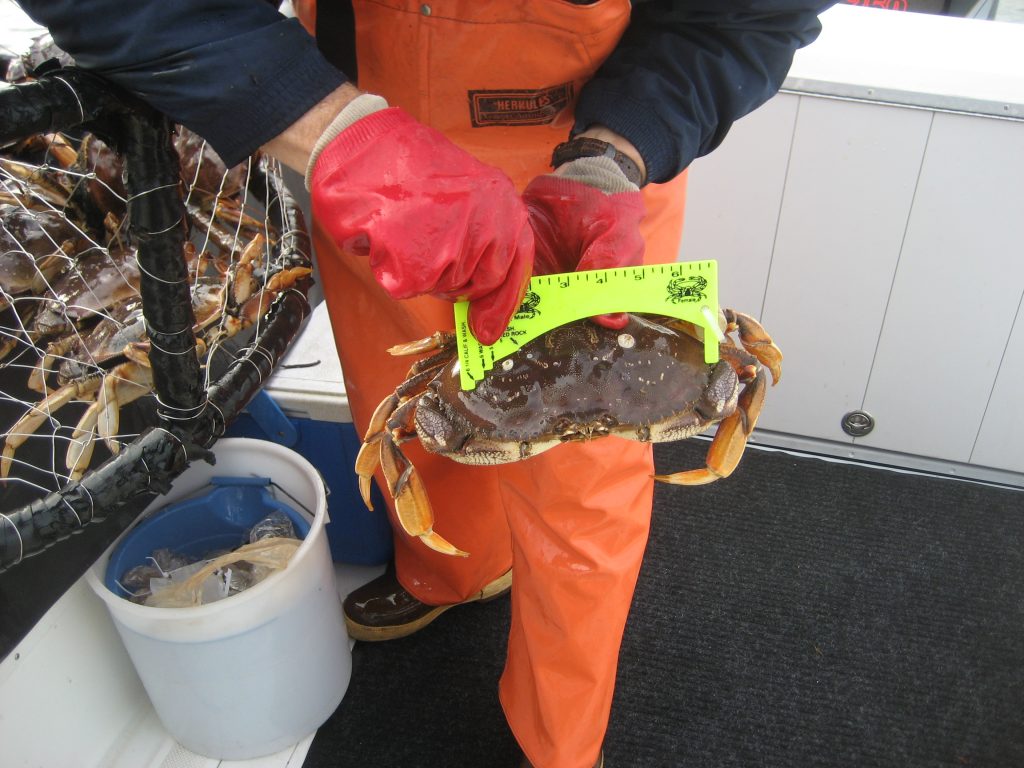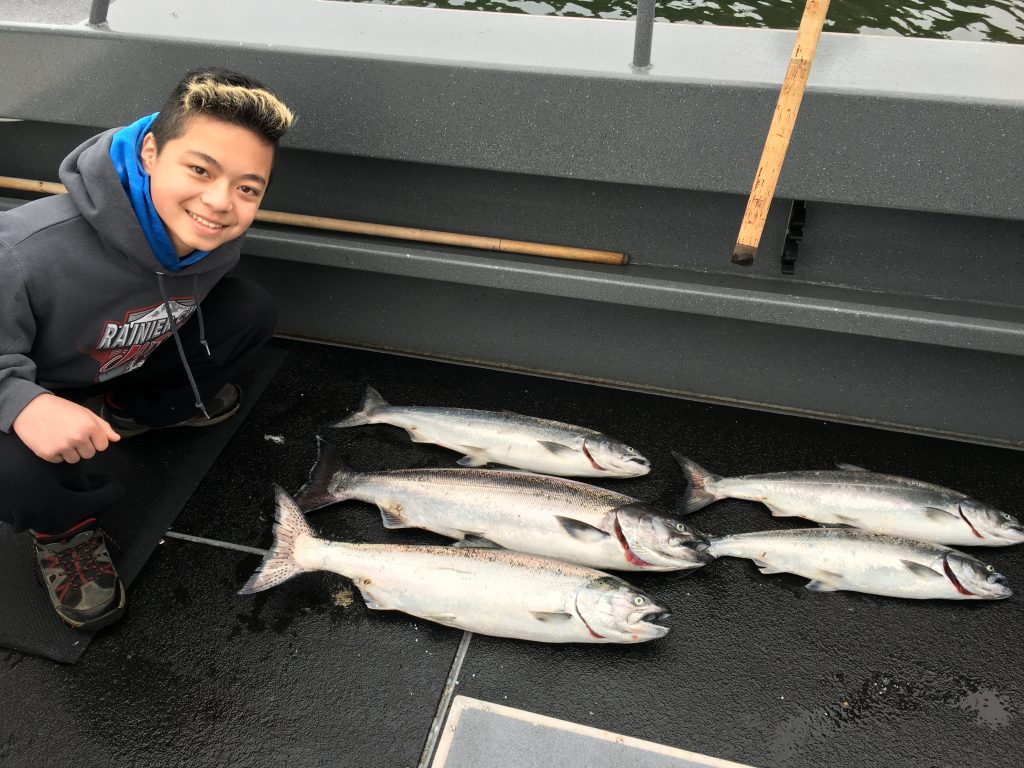Summer crab season begins July 1 around some inner-marine locations plus a few salmon fisheries get underway in the days ahead 1

Contributed by Mark Yuasa, WDFW
Anglers are in for a “clawsome” experience this summer around many inner-marine waterways as the recreational Dungeness crab fishing season begins on July 1.
“Crabbing seasons will be typical around most of Puget Sound,” Don Velasquez, a Washington Department of Fish and Wildlife (WDFW) shellfish biologist said in a news release. “Still, some areas with continued low abundance will have limited seasons or remain closed this year to promote Dungeness population recovery.”
The Dungeness crab fishery opens July 1 through Sept. 5 (crabbing allowed Thursdays to Mondays only) in the Strait of Juan de Fuca east of Bonilla-Tatoosh Island line off Neah Bay (Marine Area 4), Sekiu (Marine Area 5) and Port Angeles (Marine Area 6); the east side of Whidbey Island (Marine Areas 8-1 and 8-2); and northern Puget Sound (Marine Area 9).
Central Puget Sound (Marine Area 10) is open from July 3 through Sept. 5 and south-central Puget Sound (Marine Area 11) is open from July 3 through Aug. 30 (crabbing is allowed Sundays and Mondays only).
Hood Canal (Marine Area 12) north of a line projected true east from Ayock Point is open from July 1 through Sept. 5 (crabbing is allowed Thursdays through Mondays only).

A section of San Juan Islands (Marine Area 7 South) – San Juan Islands/Bellingham – is open from July 14 through Sept. 30 (crabbing is allowed Thursdays through Mondays only). San Juan Island’s Marine Area 7 North is open from Aug. 18 through Sept. 30 (crabbing is allowed Thursdays through Mondays only). If you go crabbing in Area 7 after Labor Day be sure to purchase your winter crab catch card.
Closed this summer for crabbing are southern Puget Sound (Marine Area 13) and Hood Canal south of Ayock Point (Marine Area 12).
In 2021, the Dungeness crab sport, non-tribal commercial and tribal fisheries caught 8,568,921 pounds. Catches have been trending downward since a record catch in 2015 when 11.8 million pounds was landed. A breakdown of the total sport crab catch was 1,739,447 pounds in all open Puget Sound areas in 2021.
The 2021 sport crab catch in western Strait of Juan de Fuca in Neah Bay (Marine Area 4) was 1,089 pounds in the summer fishery (54 pounds in the winter fishery), and at Sekiu (Area 5) was 5,154 pounds (345 pounds). The eastern Strait of Juan de Fuca (Marine Area 6) was 156,870 pounds (26,053).
The San Juan Islands (Marine Area 7) was 499,424 (60,837); east side of Whidbey Island (Marine Area 8-1) was 353,516 (19,013), and (Marine Area 8-2) was 333,045 (26,122); northern Puget Sound (Marine Area 9) was 116,077 (17,704); central Puget Sound (Marine Area 10) was 32,709 (6,272); south-central Puget Sound (Marine Area 11) was 19,690 (closed in winter); and Hood Canal (Marine Area 12) was 50,533 (14,534). Southern Puget Sound (Marine Area 13) was closed in summer and winter of 2021.
The summer — July through September — sport crab fishery continues to have the highest participation level with 225,282 summer catch cards issued to anglers in 2021 compared to 26,843 catch cards issued during the winter fishery.

Know the rules before setting crab pots
WDFW enforcement has adopted a zero tolerance on folks who don’t fill out their catch card right after landing crabs and before re-deploying traps. That means don’t blame your pen for running out of ink and be sure to carry a few extra pens to mark your catch card.
Catch record card information is vital to managing the crab fishery. Completed summer catch record cards, regardless of whether any crab were caught, must be submitted to WDFW by Oct. 1, 2022.
“It is important that crabbers return their catch record cards at the end of the season in order to help us better understand and manage this fishery,” said Velasquez. “Only about 50 percent of crabbers record their catch at the end of the season, and this information is critical for setting future seasons. We need those catch record cards returned or reported online – whether or not you caught any crab – to determine levels of sustainable catch and set harvest seasons.”
Dungeness crab must measure at least 6 ¼ inches at the widest point of the shell just in front of the rearmost point or tips. The most accurate way to measure a crab is a plastic caliper crab gauge available at most sporting goods stores.
The daily limit in Puget Sound is five male Dungeness crab in hard-shell condition. You may also keep six red rock crab of either sex daily. Red rock crab must measure at least 5 inches.
Poaching crabs by pulling a crab pot that isn’t yours is also illegal, and those caught could be charged with theft.
Crabbers also overlook the mandatory use of a biodegradable rot cord (plastic zip cords are illegal to use) to secure the lid and escape hatches on the pots. The rot cord must be untreated 100 percent cotton or other natural fiber no larger than thread size 120. This cord must be able to rot away and allow crab to escape freely. A derelict crab pot without a proper escape cord can attract and kill crabs for years after it has been lost.
Improperly marked crab pots is a violation commonly found by enforcement. Each buoy on the crab pot must have the person’s name and address.
Other violations include possession of female Dungeness crabs, keeping soft-shelled crabs, over limits, boating safety violations, and no fishing license or Puget Sound Crab Endorsement.
Catch record cards are not required to fish for Dungeness crab in the Columbia River or on the Washington coast, where crabbing is open year-round.
Tips to catch crab
There are several ways to catch crab whether it is using pots or traps from a boat or pier or even wading with a dip-net at low tide.
Crab pots are the most common way to catch crabs from a boat or from a pier and are typically set from 10 to 60 feet deep or as deep as 100 feet or more and left to “soak” for several hours.
Ring nets should be monitored more regularly as bait can be picked away by crabs that come and go as opposed to pots, which trap the crabs through one-way entry doors.
Popular bait are salmon or fish carcasses and heads, clams, squid chicken or turkey parts. Be sure to also pick up some liquid attractant at a tackle supply store and apply it to the bait to create a scent line that attracts crab from a distance.
Another way to catch Dungeness crab is by wading along the shorelines using a dip-net. Target bays with sandy bottoms and large beds of eelgrass where crab use as their habitat, and plan to hit the beach about two to three hours before low tide. Bring a bucket or a large mesh bag to carry your crabs.
The water tends to magnify things so targeting them can be tricky at times, and often a scoop of the net will result in nothing as they zip away in a cloud of kicked up silt from the net and your feet. Lastly, be quick on the scoop as they’ll often hop out of the net before you get them to the surface.
Visit the WDFW website for more details and regulations at https://wdfw.wa.gov/fishing/shellfishing-regulations/crab.

Nibbles and bites
- The Strait of Juan de Fuca, Sekiu (Marine Area 5) and Port Angeles (Marine Area 6) opens July 1 for hatchery Chinook and coho. Central Puget Sound (Marine Area 10) opens June 16 through July 13 for coho only, and for hatchery Chinook beginning July 14. The San Juan Islands (Marine Area 7) opens for hatchery Chinook July 14-16. Northern Puget Sound (Marine Area 9) opens for hatchery Chinook July 14-16 and July 21-23. South-central Puget Sound (Marine Area 11) is open Wednesdays through Saturdays only from July 1 through Sept. 30 but could close sooner for Chinook if the quota is achieved. Hood Canal south of Ayock Point (Marine Area 12) is open July 1 through Sept. 30 for coho and hatchery Chinook. Other options include the Tulalip Terminal Fishery open Fridays to Mondays only for Chinook; and southern Puget Sound (Marine Area 13) is open for hatchery Chinook and coho. Many marine area docks and piers are also open year-round for salmon.
- Coastal salmon fisheries at La Push (Marine Area 3) and Neah Bay (Marine Area 4) open daily beginning June 18 for Chinook and hatchery coho; Ilwaco (Marine Area 1) opens daily beginning June 25 for Chinook and hatchery coho; and Westport (Marine Area 2) opens daily beginning July 2 for Chinook and hatchery coho. All areas are scheduled to remain open through Sept. 30 or until quotas are achieved.
- Anglers are reeling in plenty of shad along the Lower Columbia River and expect this fishery to only gain more steam heading in the coming weeks. A massive single-day count of 136,971 shad climbed the fish ladder on Tuesday, June 14; 219,883 on Monday, June 13; and 152,269 on Sunday, June 12. In the past week, the single-day counts have peaked as high as 279,068 and raises the season total so far to 1,867,962. Try the shoreline just below Bonneville Dam, the Camas Slough, and from Washougal downstream to Kalama as well as the Willamette River in Oregon. Shad prefer swift-running current, and usually can be found less than 30 feet from the bank in water 6 to 20 feet deep. Try a variety of colored shad darts or red and white colored flies with a small hook, colored beads like red or metallic silver or gold, small crappie jigs or small wobbler spoons. There is no daily catch limit or size restriction for shad.
(Mark Yuasa is a Washington Department of Fish and Wildlife Communications Manager and longtime contributor to ESPN 710 KIRO The Outdoor Line. He also was the fishing and hunting reporter at The Seattle Times for 28 years.)


Hi Mark, I’ve been trying to figure out exactly where the area 7 summer chinook season is documented in the regs. The FishWA phone app just says open all of July for salmon and Salmon is managed as a food fish. Not very helpful for them to have an app that doesn’t give the actual seasons. Thanks for any guidance you can provide.